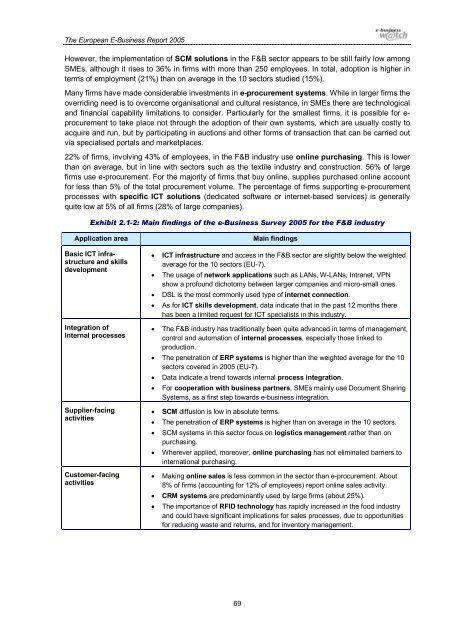The European e-Business Report The European e ... - empirica
The European e-Business Report The European e ... - empirica
The European e-Business Report The European e ... - empirica
Create successful ePaper yourself
Turn your PDF publications into a flip-book with our unique Google optimized e-Paper software.
<strong>The</strong> <strong>European</strong> E-<strong>Business</strong> <strong>Report</strong> 2005<br />
However, the implementation of SCM solutions in the F&B sector appears to be still fairly low among<br />
SMEs, although it rises to 36% in firms with more than 250 employees. In total, adoption is higher in<br />
terms of employment (21%) than on average in the 10 sectors studied (15%).<br />
Many firms have made considerable investments in e-procurement systems. While in larger firms the<br />
overriding need is to overcome organisational and cultural resistance, in SMEs there are technological<br />
and financial capability limitations to consider. Particularly for the smallest firms, it is possible for e-<br />
procurement to take place not through the adoption of their own systems, which are usually costly to<br />
acquire and run, but by participating in auctions and other forms of transaction that can be carried out<br />
via specialised portals and marketplaces.<br />
22% of firms, involving 43% of employees, in the F&B industry use online purchasing. This is lower<br />
than on average, but in line with sectors such as the textile industry and construction. 56% of large<br />
firms use e-procurement. For the majority of firms that buy online, supplies purchased online account<br />
for less than 5% of the total procurement volume. <strong>The</strong> percentage of firms supporting e-procurement<br />
processes with specific ICT solutions (dedicated software or internet-based services) is generally<br />
quite low at 5% of all firms (28% of large companies).<br />
Exhibit 2.1-2: Main findings of the e-<strong>Business</strong> Survey 2005 for the F&B industry<br />
Application area<br />
Basic ICT infrastructure<br />
and skills<br />
development<br />
Integration of<br />
Internal processes<br />
Supplier-facing<br />
activities<br />
Customer-facing<br />
activities<br />
Main findings<br />
• ICT infrastructure and access in the F&B sector are slightly below the weighted<br />
average for the 10 sectors (EU-7).<br />
• <strong>The</strong> usage of network applications such as LANs, W-LANs, Intranet, VPN<br />
show a profound dichotomy between larger companies and micro-small ones.<br />
• DSL is the most commonly used type of internet connection.<br />
• As for ICT skills development, data indicate that in the past 12 months there<br />
has been a limited request for ICT specialists in this industry.<br />
• <strong>The</strong> F&B industry has traditionally been quite advanced in terms of management,<br />
control and automation of internal processes, especially those linked to<br />
production.<br />
• <strong>The</strong> penetration of ERP systems is higher than the weighted average for the 10<br />
sectors covered in 2005 (EU-7).<br />
• Data indicate a trend towards internal process integration.<br />
• For cooperation with business partners, SMEs mainly use Document Sharing<br />
Systems, as a first step towards e-business integration.<br />
• SCM diffusion is low in absolute terms.<br />
• <strong>The</strong> penetration of ERP systems is higher than on average in the 10 sectors.<br />
• SCM systems in this sector focus on logistics management rather than on<br />
purchasing.<br />
• Wherever applied, moreover, online purchasing has not eliminated barriers to<br />
international purchasing.<br />
• Making online sales is less common in the sector than e-procurement. About<br />
8% of firms (accounting for 12% of employees) report online sales activity.<br />
• CRM systems are predominantly used by large firms (about 25%).<br />
• <strong>The</strong> importance of RFID technology has rapidly increased in the food industry<br />
and could have significant implications for sales processes, due to opportunities<br />
for reducing waste and returns, and for inventory management.<br />
69

















